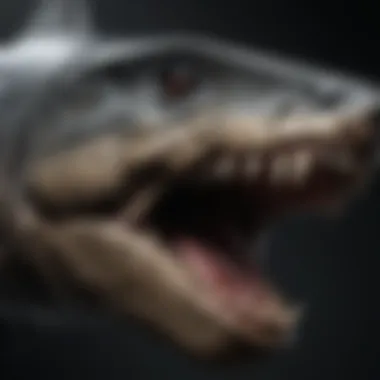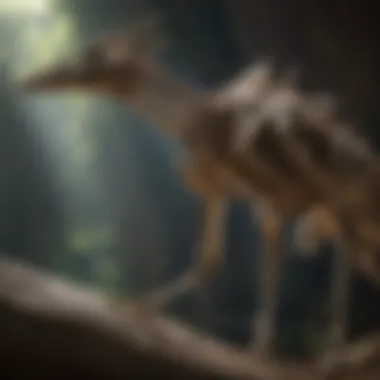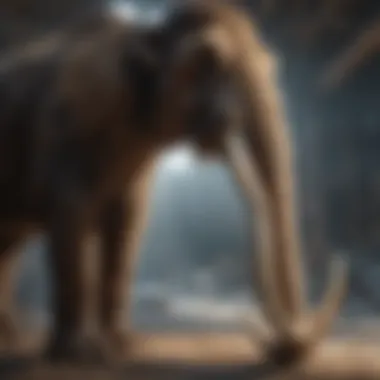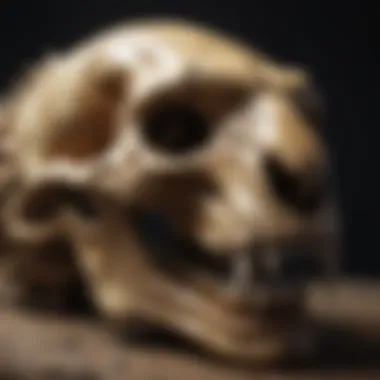Unveiling the Enigmatic World of Extinct Prehistoric Creatures


Rock and Fossil IdentificationUnderstanding different types of rocks and fossils is crucial in the world of paleontology. By discerning specific characteristics, researchers can uncover valuable insights into the ancient creatures that once inhabited our planet. Fossils can be found in various rock formations, each requiring a keen eye to identify. Tools such as hammers, chisels, and brushes are indispensable for delicate extraction. Misconceptions about fossil identification can lead to errors; precise knowledge and attention to detail are paramount.
Collecting Tips and TechniquesFor aspiring fossil collectors, adopting best practices is essential for success. Locating prime collecting sites involves thorough research and exploration. Safety measures during excavation must not be overlooked, as handling specimens can be complex and delicate. Properly documenting the discovery location is crucial for future reference. ## servation and DisplayPreserving rocks and fossils is an art in itself, requiring skill and specialized techniques. Storage methods play a critical role in maintaining the integrity of specimens. Creative display ideas can enhance the aesthetic appeal of collections, making them both educational and visually captivating. Implementing preservation methods ensures that these remnants of ancient life endure for future generations to appreciate. ## Ge ical InsightsExploring geological formations provides a gateway to understanding Earth's vibrant history. By examining fossils within their geological context, researchers can unravel the mysteries of past environments. The historical significance of rocks and fossils extends beyond mere artifacts, offering glimpses into ancient ecosystems. Notable discoveries in the field of paleontology continue to reshape our understanding of prehistoric life, underscoring the importance of ongoing geological research.
Introduction
In the sprawling arena of natural history, one cannot help but be drawn to the allure of extinct prehistoric animals. These enigmatic beings, now lost to the depths of time, offer a tantalizing glimpse into a world that existed millions of years ago, shaping the very foundation of our planet's history. As we embark on this journey to explore the remnants of ancient life forms, we are confronted with a mosaic of extraordinary creatures that once roamed the Earth with grandeur and majesty. This section serves as a beacon, guiding us through the labyrinth of evolution and extinction, unraveling tales of survival and demise that echo through the annals of time.
Understanding Extinct Prehistoric Animals
Defining Extinct Species
Embarking on the quest to define extinct species, we are thrust into a realm where the whispers of the past echo loudly in the corridors of academia. The concept of extinction, a poignant reminder of nature's transformative power, stands as a cornerstone in understanding the ever-changing tapestry of life on Earth. Delving deeper, we unearth the enigmatic nature of extinct species, encapsulating a blend of mystery and scientific precision that transcends the boundaries of time. This intricate puzzle piece in the grand mosaic of natural history beckons us to ponder the fragility and resilience of life on our planet, offering a profound insight into the forces that govern its ebb and flow.
Significance of Prehistoric Animals
The significance of prehistoric animals transcends mere fascination; it embodies a profound link to our past, a key to unlocking the mysteries of evolution and adaptation. These ancient beings, etched in the fossilized annals of history, serve as poignant reminders of the fragility and resilience of life in the face of monumental change. As we delve into their world, we are greeted with a menagerie of forms and functions that challenge our perceptions of what it means to exist in a dynamic and ever-shifting environment. The enduring significance of prehistoric animals lies not only in their physical attributes but also in the narratives they silently carry, weaving a tapestry of interconnectedness that spans millennia.
Importance of Studying Prehistoric Fauna
Studying prehistoric fauna is not merely an academic pursuit; it is a journey of discovery that unravels the intricate threads of life's tapestry. As we navigate the annals of time, traversing landscapes long lost to the ravages of change, we are presented with a compelling narrative of adaptation, survival, and extinction. The study of prehistoric fauna offers us a unique vantage point from which to observe the unfolding drama of evolution, providing valuable insights into the forces that have shaped the biodiversity of our planet. Through meticulous excavation and analysis, we piece together the puzzle of the past, shedding light on the intricate relationships that bind us to the ancient inhabitants of a world long gone.
Dinosaurs: The Giants of the Past


The realm of dinosaurs opens a portal to our ancient Earth, where colossal beings once ruled the lands with grace and power. In this article, the focus is squarely on Dinosaurs: The Giants of the Past, illuminating their immense significance in the tapestry of prehistoric life. These majestic creatures symbolize a time when Earth bore witness to unparalleled biodiversity and evolutionary marvels. Through meticulous examination of their fossilized remains and scientific analysis, we unearth a treasure trove of knowledge that not only shapes our understanding of the past but also lends insights into the dynamics of ecosystems long gone.
Tyrannosaurus Rex
- Features and Characteristics
Features and Characteristics
Tyrannosaurus Rex stands as a titan among dinosaurs, renowned for its awe-inspiring features and distinctive characteristics that distinguish it as a preeminent predator. The massive skull adorned with serrated teeth, robust limbs, and formidable stature encapsulates the essence of raw power and predatory prowess. Its unparalleled ferocity and immense size cement its status as an apex predator, an embodiment of savagery and dominance in the ancient world. Despite its towering presence, Tyrannosaurus Rex exhibits a level of intricacy in its anatomy that unveils a mesmerizing blend of strength, agility, and evolutionary adaptation, painting a vivid portrait of survival strategies honed through millennia of evolution.
- Behavior and Habitat
Behavior and Habitat
Delving into the behavioral patterns and habitat preferences of Tyrannosaurus Rex unveils an intricate tapestry of survival strategies and environmental dependencies. The predatory instincts and hunting prowess of this iconic dinosaur offer a window into the dynamics of prehistoric food chains and ecosystem balance. Roaming vast prehistoric landscapes, Tyrannosaurus Rex dominated its territories with calculated ferocity, utilizing its keen senses and physical attributes to secure its reign as a top-tier predator. Its habitat preferences, ranging from open plains to densely forested regions, reflect a versatile adaptability crucial for thriving in a volatile and competitive ecosystem. Understanding the behavior and habitat of Tyrannosaurus Rex not only enriches our knowledge of this remarkable species but also provides invaluable insights into the broader ecological dynamics of the Mesozoic era.
Brachiosaurus
- Physical Traits
Physical Traits
The majestic presence of Brachiosaurus epitomizes the grandeur of sauropod dinosaurs, with its elongated neck, towering stature, and quadrupedal stance setting it apart as an iconic herbivorous giant. Its physical traits, including a distinctive elongated neck adapted for browsing foliage at towering heights, a compact body supported by robust limbs, and a long tail for counterbalance, showcase a meticulously crafted evolutionary design tailored for efficient herbivory in a prehistoric landscape. The sheer magnitude of Brachiosaurus, coupled with its graceful demeanor and herbivorous diet, embodies a harmonious balance between size and function, offering a testament to the evolutionary innovation sculpted by millions of years of adaptation.


- Feeding Habits
Feeding Habits
Understanding the feeding habits of Brachiosaurus unravels a captivating narrative of endurance and specialized dietary preferences harmonized with the exigencies of a bygone era. Grazing on prolific flora with its elongated neck raised to astonishing heights, Brachiosaurus exemplified a niche herbivorous lifestyle that emulated a serene yet steadfast approach to sustenance. Its feeding habits not only sustained the colossal frame of this titanic herbivore but also played a pivotal role in shaping its interaction with the prehistoric environment, highlighting the subtle interplay between diet, anatomy, and ecological impact. By delving into the intricate web of feeding strategies employed by Brachiosaurus, we glean a profound appreciation for the adaptive marvels that defined the evolutionary trajectories of prehistoric megafauna.
Velociraptor
- Social Structure
Social Structure
Velociraptor, a paradigm of cunning and agility, unveils a complex social structure characterized by intricate hierarchies, communal behaviors, and cooperative hunting tactics. Thriving in pack dynamics, Velociraptor exemplifies a synergistic approach to survival that transcends individual prowess, relying on coordinated efforts and social cohesion to secure sustenance and safeguard against threats. The intricacies of its social structure offer a captivating glimpse into the evolutionary benefits of group synergy, illustrating how collaborative behaviors and interpersonal dynamics facilitated the dominance of this swift and intelligent predator within the competitive landscape of the Cretaceous.
- Hunting Techniques
Hunting Techniques
Unraveling the hunting techniques employed by Velociraptor unveils a repertoire of strategic brilliance and adaptive precision honed through the crucible of evolutionary pressures. Harnessing its speed, agility, and keen intellect, Velociraptor executed hunting strategies with surgical efficiency, leveraging pack dynamics and coordinated attacks to outmaneuver prey and secure sustenance. The distinctive hunting techniques of Velociraptor, from coordinated ambushes to strategic encirclement tactics, reflect a sophisticated understanding of predatory dynamics and ecosystem interactions crucial for survival in a tumultuous and unforgiving prehistoric world. By dissecting the nuances of its hunting prowess, we gain a deeper appreciation for the adaptive ingenuity that shaped the behavioral ecology of this iconic dinosaur and underpins its enduring legacy in the annals of paleontological fascination.
Ice Age Mammals: Survivors of Harsh Climates
Woolly Mammoth


Adaptations to Cold Environments
The Woolly Mammoth's adaptations to cold environments represent a pinnacle of evolutionary ingenuity. Its thick, insulating layer of fur, consisting of long guard hairs and a dense undercoat, provided unrivaled protection against frigid temperatures, ensuring its survival in icy terrains. Moreover, the Woolly Mammoth's compact ears reduced heat loss, while its specialized fat reserves offered a supplementary source of energy during scarce food periods. These adaptations underscore the Woolly Mammoth's exceptional ability to thrive in Arctic conditions, showcasing nature's adaptive prowess in designing resilient organisms tailored to hostile climates. The unique physiological features of the Woolly Mammoth's cold adaptations epitomize a masterpiece of biological engineering, honed through millennia of selective pressure aimed at enhancing survivability in the unforgiving landscapes of the Ice Age.
Extinction Theories
Delving into the realm of extinction theories surrounding the Woolly Mammoth unveils a tapestry of conjectures and scientific inquiries seeking to unravel the mysteries behind this majestic creature's demise. From hypotheses positing overhunting by early humans to environmental shifts triggered by climate change, the extinction theories surrounding the Woolly Mammoth signify a complex interplay of ecological dynamics and anthropogenic influences. By scrutinizing the varied conjectures regarding the Woolly Mammoth's extinction, we gain valuable insights into the intricacies of ecosystem fragility and the precarious balance that sustains biodiversity. The examination of extinction theories prompts a reflective examination of humanity's impact on prehistoric megafauna and accentuates the interconnectedness of species survival with environmental stability, underscoring the fragility of ecosystems and the imperatives of conservation efforts to safeguard Earth's biological heritage.
Smilodon
Physical Description
The detailed scrutiny of Smilodon's physical attributes unveils a portrait of a formidable predator, finely attuned to its predatory lifestyle. From its robust build and muscular physique to its distinctively elongated canine teeth, the physical characteristics of Smilodon epitomize an apex predator adapted for swift and lethal ambush tactics. The unique cranial morphology of Smilodon, characterized by its wide gape and powerful jaw muscles, facilitated devastatingly efficient killing strikes, underscoring the predatory prowess honed through evolution. By dissecting Smilodon's physical traits, we gain profound insights into the trophic dynamics of Pleistocene ecosystems, shedding light on the intricate relationships between predator and prey and the selective pressures driving morphological adaptations in apex predators.
Hunting Behavior
Exploring the hunting behavior of Smilodon unearths a compelling saga of strategic prowess and predatory finesse. The hunting strategies employed by Smilodon, marked by cooperative social structures and calculated ambush tactics, exemplify an adaptive approach towards securing prey resources effectively. Through an intricate interplay of group coordination and individual skill, Smilodon orchestrated complex hunting maneuvers, leveraging its robust physique and formidable teeth to immobilize and dispatch prey efficiently. The hunting behavior of Smilodon underscores the pivotal role of carnivores in shaping ecosystem dynamics, illustrating the delicate equilibrium that governs predator-prey relationships. By examining the nuanced nuances of Smilodon's hunting techniques, we glean invaluable insights into the evolutionary arms race between predators and prey, illuminating the intricate dance of life and death that unfolds across ancient landscapes.
Marine Reptiles: Lords of the Ancient Seas
In the realm of extinct prehistoric animals, the marine reptiles reign as majestic lords of the ancient seas, captivating the imagination with their unique adaptations and evolutionary marvels. Exploring the topic of Marine Reptiles: Lords of the Ancient Seas in this article provides a gateway to understanding a bygone era where these creatures thrived in the vast oceans, showcasing specific elements that set them apart from terrestrial dwellers. Delving into the world of marine reptiles offers insights into their unparalleled adaptations to oceanic life, shedding light on their immense importance in the evolutionary chronicles of prehistoric fauna.## iosaurus ## As issect the remarkable Plesiosaurus, let us first unravel the mysteries surrounding its exceptional Swimming Adaptations. These adaptations, characterized by streamlined bodies and powerful flippers, propelled the Plesiosaurus through ancient seas with unparalleled agility and grace. The key characteristic of these Swimming Adaptations lies in their efficiency in traversing vast ocean expanses, a trait that enabled the Plesiosaurus to hunt and evade predators with incredible precision. Its unique feature, the ability to swivel its long neck in all directions, provided a strategic advantage in capturing prey and adapting to various aquatic environments, although it was not devoid of limitations in swift maneuvering during high-speed pursuits. Transitioning to discuss the Plesiosaurus' Feeding Preferences, we encounter a fascinating aspect of its ecological niche. Ingrained in its predatory nature, the Plesiosaurus exhibited notable feeding preferences for agile marine creatures, utilizing its long, sharp teeth to grasp and consume fish and cephalopods. This specialization in prey selection underscored the Plesiosaurus's role as a formidable predator in the ancient seas, showcasing the efficacy of its feeding strategies within the complex marine food web. Highlighting these Feeding Preferences sheds light on the dietary habits and ecological interactions of this enigmatic marine reptile, enriching our understanding of its place in prehistoric marine ecosystems.## Ichthy r ## Transitio to the enigmatic Ichthyosaur, we turn our focus to its Distinctive Features that set it apart in the realm of ancient marine reptiles. The key characteristic of the Ichthyosaur's anatomy lies in its hydrodynamic body shape, optimized for swift navigation through the water with minimal resistance, portraying its evolution for efficient aquatic locomotion in pursuit of prey. This distinctive feature of sleek, fish-like body structure played a pivotal role in the Ichthyosaur's success as a marine predator, showcasing adaptions tailored for its oceanic environment by enhancing its swimming speed and agility. Delving deeper into its repertoire, we explore the Ichthyosaur's unique eye structure, characterized by large, saucer-like eyes that facilitated enhanced vision in dimly lit waters, granting it a crucial advantage in locating prey and navigating the ocean depths, although it posed challenges in brighter surface environments. Moving to dissect the Ichthyosaur's Reproductive Strategies, we uncover a vital aspect of its life cycle that contributed to its species survival and evolution. The key characteristic of the Ichthyosaur's reproductive strategies lies in its viviparous nature, where females birthed live young instead of laying eggs, a distinctive adaptation that ensured the offspring's immediate survival in aquatic environments, securing the species' continuity through maternal care and protection. Describing these Reproductive Strategies illuminates the nuanced complexities of Ichthyosaur reproduction, offering a glimpse into the evolutionary tactics that shaped its reproductive success and population dynamics under changing environmental pressures.
Concluding Remarks
As we bask in the afterglow of traversing the terrain of dinosaurs, ice-age mammals, and marine reptiles, a sense of reverence for the enigmatic specimens that graced our planet pervades our contemplations. These ancient beings, engraved in the fossilized remnants of the Earth’s narrative, beckon us to be custodians of their legacy, conveying a potent message of resilience, adaptation, and ultimately, impermanence. The Concluding Remarks tie together the threads of history, science, and wonder, binding them into a tapestry of understanding unparalleled in its complexity and profundity.
It is through the lens of Concluding Remarks that we discern the timeless relevance of prehistoric fauna to our modern lives. The echoes of extinction reverberate through centuries, prompting us to reflect on our stewardship of the Earth and its inhabitants, both past, present, and potentially futuristic. Delving into the narratives of extinction offers us not only a window into bygone eras but also a mirror reflecting our present actions and the repercussions they might sow across the fabric of time.
Furthermore, the significance of Concluding Remarks extends beyond mere recollection; it serves as a compass guiding us towards a sustainable future. As we unravel the mysteries of the past and unravel the meanings enshrined within each fossilized relic, we are beckoned towards a path of enlightenment and preservation. The awareness garnered from studying extinct prehistoric animals acts as a cautionary tale, a reminder of our interconnectedness with all life forms, urging us to tread lightly on this precious planet we call home.
In essence, the Concluding Remarks encapsulate not just the termination of our discourse but the commencement of introspection. They beckon us to pause, reflect, and internalize the profound narratives etched in the bones of the past. This final glance back into the realms of ancient creatures instills in us a sense of responsibility and awe for the intricate web of life that has unfolded over millennia, leaving an indelible imprint on our collective consciousness.







